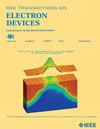金属/薄介电型p-触点圆形p-GaN/p-AlGaN棒提高258nm algan基深紫外发光二极管的壁塞效率
IF 2.9
2区 工程技术
Q2 ENGINEERING, ELECTRICAL & ELECTRONIC
引用次数: 0
摘要
极强的光吸收和较差的空穴注入效率使得gan基深紫外发光二极管(DUV LEDs)面临较低的外量子效率(EQE)和光输出功率(LOP)。为了解决这些问题,我们设计并制造了用于DUV led的圆形p-GaN/p-AlGaN棒,其金属/薄介电型p-触点。我们发现局部去除p-GaN层可以显著提高光提取效率(LEE)。然而,暴露的p-AlGaN层上的直接p型接触导致能带势垒高度增加。因此,我们在p-AlGaN层上利用基于金属/薄低k绝缘体/半导体(MIS)的p型接触来降低能带势垒高度。结果表明,MIS结构有效地促进了带内隧穿效应,提高了空穴注入效率。因此,降低了正向电压,提高了壁插效率。所提出的基于mis的p型触点也有利于器件导通前泄漏电流的减小,这体现在理想因数的减小上。通过研究抽油杆尺寸和相邻抽油杆之间的间隙,我们还发现,提高WPE需要考虑LEE和井眼注入效率之间的权衡。本文章由计算机程序翻译,如有差异,请以英文原文为准。
Circular p-GaN/p-AlGaN Rods With Metal/Thin Dielectric-Type p-Contact to Increase the Wall-Plug Efficiency for 258-nm AlGaN-Based Deep Ultraviolet Light Emitting Diodes
Very strong optical absorption and the poor hole injection efficiency make AlGaN-based deep-ultraviolet light-emitting diodes (DUV LEDs) encounter low external quantum efficiency (EQE) and poor light output power (LOP). To solve these issues, we design and fabricate circular p-GaN/p-AlGaN rods with a metal/thin dielectric-type p-contact for DUV LEDs. We find that the local removal of the p-GaN layer can significantly increase the light extraction efficiency (LEE). However, direct p-type contact on the exposed p-AlGaN layer causes the increased energy band barrier height. Hence, we utilize metal/thin low-k insulator/semiconductor (MIS)-based p-type contact on the p-AlGaN layer to reduce the energy band barrier height. The results show that the MIS structure effectively facilitates intraband tunneling effect and increase the hole injection efficiency. Therefore, the forward voltage is decreased and the wall-plug efficiency (WPE) gets improved. The proposed MIS-based p-type contact also favors the reduce leakage current before the devices are turned on, which is reflected by the reduced ideality factor. By investigating the rod sizes and the gap between the neighboring rods, we also find that the enhanced WPE shall take the tradeoff between the LEE and the hole injection efficiency into account.
求助全文
通过发布文献求助,成功后即可免费获取论文全文。
去求助
来源期刊

IEEE Transactions on Electron Devices
工程技术-工程:电子与电气
CiteScore
5.80
自引率
16.10%
发文量
937
审稿时长
3.8 months
期刊介绍:
IEEE Transactions on Electron Devices publishes original and significant contributions relating to the theory, modeling, design, performance and reliability of electron and ion integrated circuit devices and interconnects, involving insulators, metals, organic materials, micro-plasmas, semiconductors, quantum-effect structures, vacuum devices, and emerging materials with applications in bioelectronics, biomedical electronics, computation, communications, displays, microelectromechanics, imaging, micro-actuators, nanoelectronics, optoelectronics, photovoltaics, power ICs and micro-sensors. Tutorial and review papers on these subjects are also published and occasional special issues appear to present a collection of papers which treat particular areas in more depth and breadth.
 求助内容:
求助内容: 应助结果提醒方式:
应助结果提醒方式:


